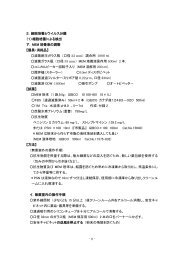Program and Abstracts(PDF)
Program and Abstracts(PDF)
Program and Abstracts(PDF)
You also want an ePaper? Increase the reach of your titles
YUMPU automatically turns print PDFs into web optimized ePapers that Google loves.
Presentation 20<br />
INLAND MARINE FISH CULTURE IN LOW-SALINITY RECICULATING<br />
AQUACULTURE SYSTEM<br />
Marty A. Riche *1 , Timothy J. Pfeiffer 1 , Paul S. Wills 2 , Jon J. Amberg 3 <strong>and</strong> Maria S. Sepulveda 4<br />
1 United States Department of Agriculture, Agricultural Research Service, Sustainable Marine<br />
Aquaculture Systems 5600 US Highway 1, North, Fort Pierce, Florida, USA<br />
2 Harbor Branch Oceanographic Institute, Florida Atlantic University, Center for Aquaculture <strong>and</strong><br />
Stock Enhancement, 5600 US Highway 1, North, Fort Pierce, Florida, USA<br />
3 United States Geological Survey, Upper Midwest Environmental Sciences Center, 2630 Fanta<br />
Reed Road, La Crosse, Wisconsin 54603, USA<br />
4 Purdue University, Department of Forestry <strong>and</strong> Natural Resources, 715 West State Street, West<br />
Lafayette, Indiana 47907, USA<br />
*Email: marty.riche at ars.usda.gov<br />
A growing <strong>and</strong> increasingly health-conscious population, coupled with declining capture fisheries<br />
is driving an increased global dem<strong>and</strong> for farm-raised seafood that can only be met through<br />
expansion of aquaculture. In 2007, aquaculture represented 33% of total global seafood<br />
production <strong>and</strong> is projected to increase to as much as 71% by 2030. The U.S. aquaculture<br />
industry represents a $1.0 billion/year industry, but is principally based on production of<br />
freshwater finfish. In contrast, on a global scale marine aquaculture comprises one-third of<br />
farmed production, <strong>and</strong> cultivation of marine aquatic animals represents the fastest growing<br />
segment within aquaculture. This suggests tremendous potential for growth of a developing U.S.<br />
marine aquaculture industry. However, development <strong>and</strong> expansion of marine aquaculture is<br />
challenged by the high cost <strong>and</strong> limited availability of coastal l<strong>and</strong> <strong>and</strong> water resources, effluent<br />
concerns, high production costs, restricted growing seasons, lack of quality seedstock, <strong>and</strong><br />
inadequate regulatory <strong>and</strong> permitting processes. Many of these constraints can be addressed<br />
using inl<strong>and</strong> marine fish culture in low-salinity recirculating aquaculture systems as a production<br />
model. We describe recent <strong>and</strong> ongoing development of technologies in four principal areas: 1)<br />
engineering <strong>and</strong> system design; 2) year-round production of seedstock; 3) diet development; <strong>and</strong><br />
4) physiological adaptation of marine fish to low-salinity environments using genomic<br />
approaches. It is anticipated these technologies could find application for rearing euryhaline<br />
marine fish throughout approximately 2/3 of the U.S. where lightly saline groundwater is<br />
available. Development of technologies for rearing marine species that can be adapted to lowsalinity<br />
or freshwater environments in recirculating systems will reduce the need to be located<br />
near coastal l<strong>and</strong>, reduce saltwater effluent, <strong>and</strong> reduce the carbon footprint of marine finfish<br />
production.<br />
ANNOTATED BIBLIOGRAPHY OF KEY WORKS<br />
39



